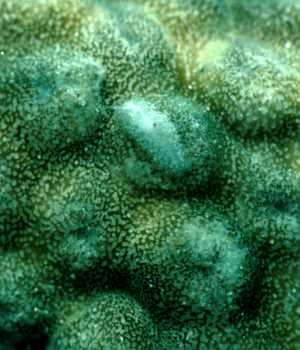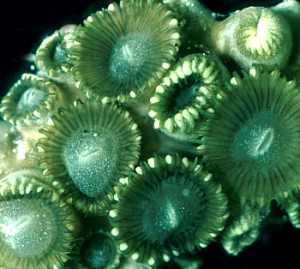

Aeolidiopsis ransoni
- Biology
Specimens of Aeolidiopsis ransoni are found living on colonial zoantharians of the genus Palythoa. The nudibranch is particularly well camouflaged, the pale form actually burrowing into the Palythoa colony and being covered with a layer of sand grains which are incorporated into the zoantharian's tissues. The brown form so resembles the external colour of the brown Palythoa that it is almost invisible. The habit of flattening the laterally-held cerata against the sides of the body, with the distal part held out horizontally just above the foot, adds to the camouflage, the aeolid appearing as a small, low, rounded lump on the surface of the colony. Two features of particular interest are that Aeolidiopsis ransoni has two colour phases and in the brown phase, it harbours zooxanthellae, symbiotic dinoflagellates, which it obtains from eating Palythoa. In Aeolidiopsis, the zooxanthellae are found within the cells of the digestive gland both in the cerata and the body cavity. Throughout the dorsal body wall are fine ducts of the digestive gland lined with small regular cells, each containing one zooxanthella. The cells are quite unlike the normal cells of the digestive gland and appear to be specially modified for harbouring zooxanthellae. Flattening of the oral tentacles and the cerata, decrease in number of the cerata, and their arrangement in almost lateral rows, are all morphological adaptations to increase surface areas on which light can fall. Ramifying the digestive gland to all parts of the body allows the maximum number of zooxanthellae to be placed in optimal localities for photosynthesis. See the Solar powered Nudibranch Page for further information on other nudibranchs with similar adaptations.
The two colour phases are related to symbiosis with zooxanthellae. The brown speckled form has many zooxanthellae within the cells of the digestive gland; in fact the colour is zooxanthellae pigment. The translucent white form has very few zooxanthellae in its tissues. Whether the two colour forms are merely phases in a cyclic turnover of zooxanthellae or distinct physiological variants must await further study. Among the specimens I have examined there are no intermediates. The two colour forms also differ in behaviour. The brown-speckled form was always found crawling on the surface of the Palythoa colony, whereas the translucent form burrows under the surface of the colony. Beneath the thin epidermal laver of Palythoa, in the region between polyps, there is a layer of sand grains incorporated by the colony into a subepidermal skeleton. The translucent form tunnels through this laver, making a groove overlain with sand grains embedded in mucus. The animals are nearly invisible in the field and were found by bringing colonies back to the laboratory and leaving them in shallow dishes of sea water until the animals crawled out. There is an obvious correlation between the surface living, brown-speckled form having abundant zooxanthellae, and the burrowing, translucent form with very few. Obviously the burrowing form is shaded and zooxanthellae would not be in an optimum environment, but why some members of the species should burrow and others not is an unanswered question at this stage.
Reference:
· Rudman, W.B. (1982) The taxonomy and biology of further aeolidacean and arminacean nudibranch molluscs with symbiotic zooxanthellae. Zoological Journal of the Linnean Society, 74: 147-196.
Rudman, W.B., 2002 (July 19) Aeolidiopsis ransoni - Biology. [In] Sea Slug Forum. Australian Museum, Sydney. Available from http://www.seaslugforum.net/factsheet/aeolransbiol
